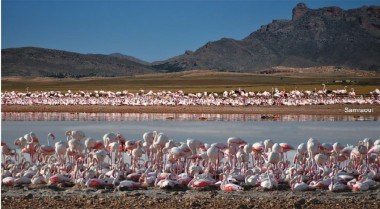Nakuru National Park
Lake Nakuru National Park is about 188 km2, 73 miles2), was created in 1961 near Nakuru Town. It is best known for its thousands, sometimes millions of flamingos nesting along the shores. The surface of the shallow lake is often hardly recognizable due to the continually shifting mass of pink. The number of flamingos on the lake varies with water and food conditions and the best vantage point is from Baboon Cliff. Also of interest is an area of 188 km (116 miles) around the lake fenced off as a sanctuary to protect giraffes as well as both black and white rhinos.
The park has recently been enlarged partly to provide the sanctuary for the black rhinos. This undertaking has necessitated a fence - to keep out poachers rather than to restrict the movement of wildlife. The park marches for 12.1 km on the south eastern boundary with the Soysambu conservancy which represents a possible future expansion of habitat for the rhinos and the only remaining wildlife corridor to Lake Naivasha.
The park in (2009) had more than 25 eastern black rhinoceros, one of the largest concentrations in the country, plus around 70 southern white rhinos. There are also a number of Rothschild's giraffe, again relocated for safety from western Kenya beginning in 1977. Waterbuck are very common and both the Kenyan subspecies are found here. As well as flamingos, there are myriad other bird species that inhabit the lake and the area surrounding it, such as African fish eagle, Goliath heron, hamerkop, pied kingfisher and Verreaux's eagle among others.

